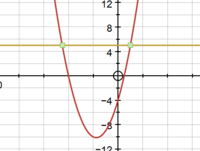You are using an out of date browser. It may not display this or other websites correctly.
You should upgrade or use an alternative browser.
You should upgrade or use an alternative browser.
Question under differentiation chapter
- Thread starter QueekJJ
- Start date
D
Deleted member 4993
Guest
Since you are lost in the beginning - let's start with definition:View attachment 25713
I had this question and got lost on where i should start. Also please do not give me answers straight away, just give me like ideas on what steps i should do so i can learn
What is the definition (mathematical) of the gradient of the curve?
pka
Elite Member
- Joined
- Jan 29, 2005
- Messages
- 11,974
Here is a start: \(x^2+7x-9)=(2x+9)(x-1)\).View attachment 25713I had this question and got lost on where i should start. Also please do not give me answers straight away, just give me like ideas on what steps i should do so i can learn
HallsofIvy
Elite Member
- Joined
- Jan 27, 2012
- Messages
- 7,763
-"The curve \(\displaystyle y= 2x^2+ 7x- 4\) and the line y= 5 meet at the points P and Q."
The first thing you need to do is find the points P and Q: solve \(\displaystyle 2x^2+ 7x- 4= 5\).
That is the same as \(\displaystyle 2x^2+ 7x- 9= 0\) and, as pka points out, \(\displaystyle 2x^2+ 7X- 9= (2x+ 9)(x- 1)\). Once you know P and Q, evaluate the derivative of \(\displaystyle 2x^2+ 7x- 9= 0\) at those points.
The first thing you need to do is find the points P and Q: solve \(\displaystyle 2x^2+ 7x- 4= 5\).
That is the same as \(\displaystyle 2x^2+ 7x- 9= 0\) and, as pka points out, \(\displaystyle 2x^2+ 7X- 9= (2x+ 9)(x- 1)\). Once you know P and Q, evaluate the derivative of \(\displaystyle 2x^2+ 7x- 9= 0\) at those points.
Ah sorry for the late reply, wasn't able to use my gadget the pass few days... Thanks apple2357 and Hallsoflvy for the help, i now finally understood the question and the steps to answer it.
Just to confirm it, the answer gotten is 11 and -11. Am I correct?
Just to confirm it, the answer gotten is 11 and -11. Am I correct?
D
Deleted member 4993
Guest
Answer for what?Ah sorry for the late reply, wasn't able to use my gadget the pass few days... Thanks apple2357 and Hallsoflvy for the help, i now finally understood the question and the steps to answer it.
Just to confirm it, the answer gotten is 11 and -11. Am I correct?
You were asked to calculate gradient !
Please share your work.
Ah sorry for the late reply, wasn't able to use my gadget the pass few days... Thanks apple2357 and Hallsoflvy for the help, i now finally understood the question and the steps to answer it.
Just to confirm it, the answer gotten is 11 and -11. Am I correct?
I can confirm the gradient at the two points of intersection are 11 and -11.
Can you see how the graph suggests a symmetry?
Your answer is correct, and I suspect your reasoning was correct, but your presentation is hard to follow and outright wrong in one respect.
[MATH]\dfrac{dy}{dx} \text { is NOT equal to } 2x^2 + 7x - 4 \text { because } y = 2x^2 + 7x - 4.[/MATH]
What you could have shown is
[MATH]f(x) = y = 2x^2 + 7x - 4.[/MATH]
[MATH]y = 5 \implies 2x^2 + 7x - 4 = 5 \implies x = \dfrac{- 7 \pm \sqrt{49 - 4(2)(-9)}}{2 * 2} = \dfrac{-7 \pm {49 + 72}}{4} = 1 \text { or } - 4.5.[/MATH]
[MATH]\dfrac{dy}{dx} = 4x + 7 = f’(x).[/MATH]
[MATH]f’(1) = 4 * 1 + 7 = 11.[/MATH]
[MATH]f’(-4.5) = 4(-4.5) + 7 = - 18 + 7 = - 11. [/MATH]
Good work. Correct answers are a whole lot more important than presentation that is sweet and neat.
[MATH]\dfrac{dy}{dx} \text { is NOT equal to } 2x^2 + 7x - 4 \text { because } y = 2x^2 + 7x - 4.[/MATH]
What you could have shown is
[MATH]f(x) = y = 2x^2 + 7x - 4.[/MATH]
[MATH]y = 5 \implies 2x^2 + 7x - 4 = 5 \implies x = \dfrac{- 7 \pm \sqrt{49 - 4(2)(-9)}}{2 * 2} = \dfrac{-7 \pm {49 + 72}}{4} = 1 \text { or } - 4.5.[/MATH]
[MATH]\dfrac{dy}{dx} = 4x + 7 = f’(x).[/MATH]
[MATH]f’(1) = 4 * 1 + 7 = 11.[/MATH]
[MATH]f’(-4.5) = 4(-4.5) + 7 = - 18 + 7 = - 11. [/MATH]
Good work. Correct answers are a whole lot more important than presentation that is sweet and neat.
Yeh i just realized my mistake on doing my working after what JeffM said. Thanks <3You wrote that 2x^2 + 7x - 4 = 4x+ 7. Do you know what '=' means?


